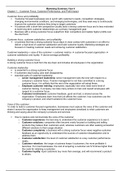Marketing Summary Year 4
Chapter 1 – Customer Focus, Customer Performance, and Profit Impact
Customer focus and profitability
‘Customer focused businesses are in synch with customer’s needs, competitors’ strategies,
changing environmental conditions, and emerging technologies, and they seek way to continuously
improve the customer solutions they bring to target customers.’
A business with a short-tern perspective usually lacks a strong customer focus and is less motivated
to build long-term customer relationships as a primary management goal.
Business with a strong customer focus outperform their competitors and realize higher profits over
the short term.
Customer focus, customer satisfaction, and profitability
a business that has a strong customer focus stays in close contact with customers in an effort to
deliver a high level of customer satisfaction and build customer loyalty. Marketing strategies are
focused on meeting customer needs and achieving customer satisfaction.
Customer leadership + voice of the customer + customer metrics customer-focused organization
customer satisfaction and loyalty above-average profitability
Building a strong customer focus
A strong customer focus is built from the top down and includes all employees in the organization.
Customer leadership
is essential to a strong customer focus
if customers stop buying, jobs start disappearing
essential parts of customer leadership:
o senior management leadership: senior management sets the tone with respect to a
company’s customer focus. If senior management is not fully committed to a strong
customer focus, it is unlikely that the rest of the organization will adopt these.
o Employee customer training: employees, especially new ones need some level of
customer training. A company can take many actions to train and reward employees with
respect to a customer focus.
o Customer involvement: customer feedback, good and bad, is shared across the
organization. Employees learn how their job affects the customer, how customers use the
company’s product, and what frustrations the customer have.
Voice of the customer
‘In order to build a customer-focused organization, businesses must capture the voice of the customer and
share it across the organization to keep management and employees sensitized to what customers are
thinking and saying about the company’s products and services.’
How to capture and communicate the voice of the customer:
o Customer experience: the best way to understand the customer experience is to see it.
o Customer solutions: companies often become overly focused on building and selling
products they believe their customers want, whereas customers are often seeking somewhat
different solutions to their usage situation.
o Customer complaints: a business with a strong customer focus views negative customer
feedback as an opportunity to understand the sources of customer dissatisfaction and to
address them.
o Customer satisfaction: the level of customer satisfaction is a key customer performance
metric.
o Customer retention: the longer a business keeps it customers, the more profitable it
becomes. For most businesses, the cost of acquiring a customer are 5/10 times higher than
the costs for retaining a customer.
o Customer loyalty: loyal customers buy more than average, and will recommend a product
to others.
,A wide-angle view of customer satisfaction
Customer satisfaction is a valuable marketing performance metric because it can forecast revenues and
profits.
Other measures of market performance, such as sales and market share, are backward-looking
measures of success or failure. They tell how well the firm has performed in the past, but they tell
nothing about the future.
If customer satisfaction is declining, this early warning sign gives management time to take pre-
emptive action before real damage is done.
Managing customer dissatisfaction
Market-based management business gives its dissatisfied customers as much attention as its ‘very
satisfied customers. When a dissatisfied customer leaves, a business suffers several economic
consequences that lower profits.
Main reason to include your dissatisfied customers in your strategy is because attaining a new one
costs you way more.
To prevent a poor reputation from developing by word of mouth, a customer-focused business
encourages dissatisfied customers to complain.
When complaints can be resolved quickly, 95% of complaining customers are retained. When
complaints cannot be resolved within 24 hours, the retention rate falls to 46%.
Profit impact of customer retention
The marketing costs of retaining customers is much lower than the costs of replacing them.
Because the business has fewer lost customers and needs fewer new customers to replace them.
Customer satisfaction and customer retention
In less competitive markets, customers are more easily retained even with low levels of customer
satisfaction because of lack of substitutes or because of high switching costs.
In markets with relatively few choices (water service, electricity, hospital) customers stay even when
they are dissatisfied.
However, in highly competitive markets, even high levels of customer satisfaction may not prevent
customer defection. In these markets a very high level of satisfaction is needed to ensure a high
percentage of retained customers.
Some businesses are one step removed from the end customer and therefore cannot determine
their customer retention rates on the basis of customer transaction records. They can use a
customer survey.
Customer retention and customer life expectancy
Customer satisfaction and retention rates are important linkages to a market-based strategy and to
profitability.
The higher the customer retention rate, the greater the profit impact. In the short run, it is showed to
be true on the basis of increased profits from retained customers, reduced losses from defecting
customers, and subsequent lower cost of attracting new customers.
As customer retention increases, the customer’s life expectancy increases. Customer life
expectancy increases exponentially with customer retention.
Customer lifetime value
In general, it costs five times more to replace than to keep a customer.
The higher the customer retention, the longer the average customer life expectancy and the greater
the customer lifetime value.
Customer loyalty
Loyal customers have a longer history, are more committed to the company brand and buy more.
Repeat customers also have a long history, but are less committed to the brand and buy less than
loyal customers. They are also less likely to recommend the brand to others.
Measuring customer loyalty
Customer loyalty varies on the basis of the five customer loyalty components:
1. Customer history
2. Purchase amount
3. Desire to purchase
, 4. Product preference
5. Would recommend
To be classified as a loyal customer, a customer should have a loyalty score between 70 and 100.
Loyal customers
Loyal customers need to be managed differently. They should be rewarded for their loyalty with
special offers and services that are not offered to other customers.
Many loyal customers produce a referral value that is over three times their customer lifetime value.
Repeat customers
Many repeat customers are simply ‘big spenders’. They buy a lot from many companies and have
no preference.
They have an excellent retention rate.
Repeat customers are loyal customers in waiting.
Repeat customers have an average to above-average customer lifetime value, but one that is lower
than that of loyal customers.
Companies often oversee repeat customers and overlook opportunities to make them loyal
customers.
Captive customers
Captive customers are dissatisfied customers who have an average to long customer history.
They have a low desire to repurchase but are unable to move easily to another company’s product.
They have a weak product preference and would not recommend the product to someone else.
In most cases the customers are locked into their next purchase or simply cannot switch.
Captive customers have an average customer history and a positive cash flow, but their future cash
flow is t risk because they want to switch.
Captive customers are likely to share their frustrations which might make it harder for the company
to attract new customers.
New customers
This can be first time customers or returning customers.
They have a low to average customer history.
Below-average to low customer lifetime value.
Less likely to recommend the product.
Unprofitable customers
Offerings of the current business do not fit their needs.
They are unlikely to be retained.
‘spinners’ are another group. These buy one time and then exit.
Understanding the difference between target and nontarget customers is important. A customer acquisition
process that profiles unprofitable customers and helps the company avoid them will lower the cost of
attracting new customers and improve the business’s customer retention rate.
Managing customer loyalty
An effective program starts by identifying the target customers a business can acquire and retain,
and it includes strategies for managing new customers and abandoning unprofitable ones.
, Chapter 2 – Marketing Metrics and Marketing Profitability
Measuring performance
Financial measures do not provide an external or market-based view of performance. From the
financial measures alone, we cannot tell how Biotronics performed relative to the external
benchmarks of market growth, competitive pricing, relative product and service quality.
A marketing-metrics-based strategy
Not attracting new customers during a period of market growth simply means a business will have to
work harder and spend more to regain its previous market share.
Financial metrics versus marketing metrics
These internal metrics do not provide the needed insights into how the business or a product is
performing in the market.
External metrics are leading indicators of future financial performance.
Marketing performance metrics are at the heart of market-based management because they tell us
how a product or business is performing in the market. They are important for two reasons:
1. They provide measures of marketing performance, such as customer satisfaction,
retention and loyalty.
2. Marketing performance metrics are correlated with profitability.
Different market metrics
Market metrics: market metrics measure a market with respect to current performance and profit impact.
Customer metrics: customer metrics gauge a business or product in terms of its performance with
customers.
Competitiveness metrics: these metrics index a business or product against benchmark competitors with
respect to product performance, service quality, brand image, costs of purchase, and customer value.
Market profitability metrics: marketing ROI is a key marketing profitability metrics that measures the profit
impact of an investment in marketing and sales expenses.
Internal vs external metrics
A business needs both internal and external performance metrics.
Internal company metrics: track product defects, late deliveries, late payments, inventory
turnover. Also, unit costs, expenses, asset utilization, employee and capital productivity, and overall
financial profitability.
External marketing metrics: provide a view of a company from a market-based perspective. They
track the levels of awareness that customers have of a company’s product, the customer’s overall
satisfaction, their perceptions of product performance, and their intentions to repurchase.
Forward-looking versus backward-looking metrics
Forward-looking metrics: indicate future performance and are applied at regular intervals during a
company’s reporting period. The backward-looking metrics, measure past performance and are applied
at the end of the reporting period.
Net marketing contribution: sales revenue x percent gross profit – marketing and sales expense.
market demand x market share x average selling price x channel discounts x percent margin –
marketing & sales expense
Marketing profitability and ratio metrics
Marketing ROS = net marketing contribution/sales
Marketing ROI = net marketing contribution/marketing and sales expense
the answer of this means that for each dollar a company invests, it produces the amount in marketing
profits.
Market demand (units): the size of the served market (number of units purchased annually).
Market share (%): the business’s market share of the served market.
Average selling price ($ per unit): the price paid by end customers who will use the product.
Channel discount (1 – CD%): the amount the company must pay to compensate channel intermediaries
for channel services, such as sales, distribution, and customer service. One minus the perfect channel
discount is the percentage of the market sales that the company will obtain after paying channel
intermediaries for services provided.






